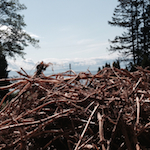In starting the arduous job of preparing our vegetable garden for the upcoming May long weekend, I had to remove the forest of stinging nettle that had taken over the area. Our garden is new to us, provided as a part of the amazing house we live in on the Sunshine Coast. After being nearly stung to death by the nettles, I finally got all of them removed and even collected some of the leaves to make some nettle leaf tea.
One thing I was really excited about in starting the garden was getting the necessary tools. We didn’t really want to go all in yet so we got ourselves the essentials. A shovel and a rake. We also bought all of our supplies including 6 different varieties of tomatoes, 4 varieties of peppers, strawberries, lettuce, radish, zucchini, some token sunflowers and organic fertilizers. We got back to the house and got right to work. Since it started to rain a little, I got my shovel into the ground but I never expected what happened next.
The soil was pretty nice and soft so I expected the digging to be easy, but what I was not expected was the sea of nettle root just bellow the surface. Of course being a naturopathic doctor, I looked at this mild disaster as an opportunity and proceeded to collect all of it to make a giant batch of nettle root tincture. In reflecting on the 30 or so pounds of nettle root (picture) I had collected, it dawned on me that during the spring, there is an abundance of indigenous plants that have very powerful spring cleansing properties growing right in my backyard, including dandelion, burdock root, horse tail and of course nettle.
Nettle root can be used for a host of problems and has quite a lot of scientific support for its use (http://www.ncbi.nlm.nih.gov/pubmed/?term=urtica+dioica). My tincture is going to be an alcohol extraction started as a 1:1 and diluted to 1:5 with 40 % alcohol. I’m looking forward to being glycemicaly controlled, free flowing, non- achy, and uncongested with glowing skin, all thanks to my backyard!
The uses for nettle are courtesy of ND Assist and include but are not limited to;
• benign prostatic hyperlasia (BPH)
• polycystic ovary syndrome (PCOS)
• urinary tract infections (UTI)
• atopic diseases (internal use)
– eczema
– seasonal allergies
– allergic rhinitis
• rheumatic conditions
– osteoarthritis
– gout
– arthritis (fresh herb topically)
• diarrhea
• acne
Actions:
• antiandrogen
• astringent
• nutritive
• rubefacient
• counterirritant
• antiinflammatory – decreases LOX, COX & TNF
• diuretic – due to high potassium
• galactogogue
Constituents:
• Phytosterols (modulate hormone receptors)
• Lignins (modulate hormone receptors)
• Flavonoids
• Iron
• Potasium (very high relative to sodium content)
• Formic acid (fresh herb only)
Posology:
• Extract (1:5 root): 600-1200 mg qd
• Tincture (1:5 in 40% EtOH): 2.5-5 ml tid
• Infusion (dried herb): 1-3 tsp tid
• Fresh herb: steamed and ingested as a spring vegetable
Safety:
Generally considered safe when used as indicated.
References:
Barnes J, Anderson LA, Phillipson JD. Herbal Medicines, 3rd ed. London: Pharmaceutical Press, 2007.
Bone K. Principles and Practice of Phytotherapy. Edinburgh: Churchill Livingstone, 2000.
Bone K. A Clinical Guide to Blending Liquid Herbs: Herbal Formulations for the Individual Patient. St Louis, MO: Churchill Livingstone, 2003.
Brinker F. The Toxicology of Botanical Medicines, 3rd ed. Sandy, Oregon: Eclectic Medical Publications, 2000.
Felter HW, Lloyd JU. King’s American Dispensatory. 1898. http://www.ibiblio.org/herbmed/eclectic/kings/main.html. Accessed: August 19, 2006.
Hoffman D. Medical Herbalism. Rochester, Vermont: Healing Arts Press, 2003.
Weiss RF. Herbal Medicine. Beaconsfield, England: Beaconsfield Publishers Ltd, 1988.
Williamson EM, ed. Major Herbs of Ayurveda. Edinburgh: Churchill Livingstone, 2002
